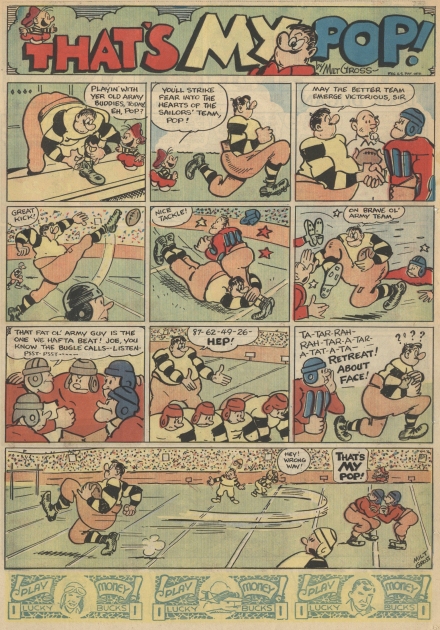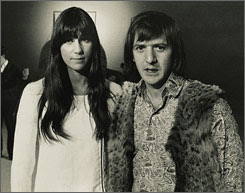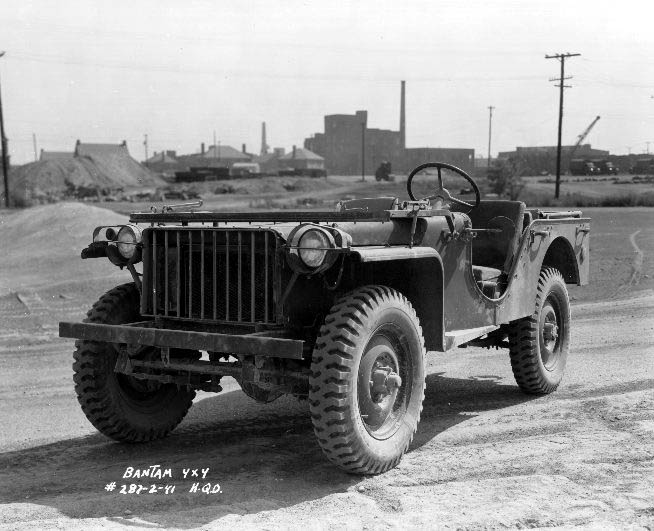
Jeep! Jeep!
This is part two of our survey of language spawned by comics and cartoons.
Here’s a strip that, in comics, is one of the richest contributors to the language: Thimble Theatre, better known worldwide by the name of its protagonist, the sailor Popeye.
The strip’s creator, Elzie Segar (1894– 1938) is credited with several coinages, some of which are contested; let’s take them one by one.
“With a loanshark, it’s simple: you don’t pay, he sends one of his goons to break your leg“.
To Segar is generally attributed the word “goon”, but the truth is a bit more complex; the word long predated the strip.
However, it is arguable that Segar changed the sense of this slang term. Before, it designated a foolish simpleton.
But by the end of the thirties, after Segar introduced the fearsome but lovable Alice the Goon into the strip:
click image to enlarge
… the meaning changed to that of a hulking, violent thug.
I’ll vote for Segar on this point (although some maintain the word in its modern sense derives from goondah, a Hindi word for a tough crook. This is superficially plausible, as many expressions from India have found their way into colloquial British English, such as “take a dekko” for “take a look”, or “he’s a pukkah sahib” for “he’s an honourable man”. But the new sense of ‘goon’ seems to have gone from America to Britain, not vice-versa; I still vote for Segar…and the dictionaries agree.)
“It was more a dirt track than a road; good thing we were driving a Jeep“.
Another contested usage attributed to Segar concerns his character Eugene the Jeep.
A strange, doglike creature from Africa, from its introduction in 1936 it was an instant hit with readers.

Soon the word ‘jeep’ had entered the slang in a variety of applications. It could refer to rookie soldiers, odd new gadgets and gizmos; in the pioneer days of television, it designated a portable t.v. studio.
It mainly referred to vehicles, such as trucks and tanks. Finally, the name stuck to the 1941 M-38 Truck, Utility, 1/4 Ton, henceforth universally named the Jeep:
The alternative etymology — that the name of the vehicle derives from “GP”, for “general purpose”, has been widely debunked.
“She says I smoke, drink and cuss too much. Phooey on that, I yam what I yam.“
Popeye’s profession of individuality was perhaps not original — Jehovah said it first to Moses — but it spread wide and far through the theme song of his animated cartoons.
“Perhaps they calculated that winning health care would strengthen them for climate change, like Popeye after a helping of spinach. — Hendrick Hertzberg, The New Yorker, Feb 7 2011.
As for his strength-giving spinach, it also led people boasting of their physical prowess to say that they “eat their spinach”.

“That guy’s a particularly insidious Internet troll; he eggs each party on to attack the other — the old let’s-you-and- him- fight technique.”
Popeye’s friend J.Wellington Wimpy was not a courageous soul, to say the least.
(Hence the word wimp, as some have claimed? Actually, ‘wimp’ is from a 1920s slang term for ‘woman’. Yep, sexism rides again.)
His ‘Let’s you and him fight’ was one way he deflected wrath away from himself.
Wimpy was a moocher, and he often tried to satisfy his lust for hamburger sandwiches with the following promise:

The phrase is still used to warn of an improvident borrower (Wimpy never repaid his loans), as this recent adaptation of the idiom by Political Graffiti cartoonist Bob McCarty shows:
” I”m feeling peckish; anyone fancy going for a wimpy?”
Wimpy’s association with hamburgers led to the 1954 founding of Britain’s first hamburger chain, Wimpy Bar. So ubiquitous were these restaurants in the days before American chains like McDonald’s crossed the Atlantic that wimpy became, for a while, synonymous with ‘hamburger’ in British English.
************************************************************
“He says he’s only in it out of charity, not for profit; well banana oil to that!”
As you will read in R.C. Harvey’s “engrossing” article on Gross , Milt Gross (1895 – 1953) was also a coiner of phrases; my favorite is a contemptuous rejoinder to any hypocritical statement, “Banana oil!”

“Dad tried to make home-brewed beer, but ended up covered in gook when the concoction blew up on him. Haw! That’s my Pop!“

The affectionate exclamation “That’s my Pop!” was also from a Gross strip, popularised further by a radio show of the same name. (Thanks to R.C.Harvey and Craig Yoe for the info.)
************************************************************
” They want to fix global warming by shooting sulphuric acid into the stratosphere via an eighteen-mile-high pipe; typical Buck Rogers solution. Congress ought to zap that proposal right away.”
The first regular science fiction comic strip, Buck Rogers has given its name to any wildly futuristic technology, with overtones of derision.
Buck Rogers as drawn by Dick Calkin
The strip also introduced the sound effect “Zap!” to illustrate the sound of a raygun; hence “zap gun” or “bug zappers”

Of course, to zap now means to strike decisively and speedily; to put someone down with a crushing retort; to remote-switch channels on television… a protean verb, indeed.
************************************************************
“Sonny Bono pioneered the rich hippie look, which included his trademark Prince Valiant haircut, and, more importantly, a fur vest.”– from fashion blog Stylesnatcher
Prince Valiant is the classic adventure comic strip created by Hal Foster (1892 — 1982). One visual trademark of its swashbuckling hero is his distinctive hairstyle, with its forehead-sheilding bangs and long locks in back:

This inspired the Prince Valiant Haircut, which on most men — as the sneering quote above implies– has tragic consequences:

… especially if you’re Sonny Bono.
************************************************************
” I’d better get back to work. My supervisor is the original Dragon Lady — if I’m a minute late, she’ll dock my pay.”

Milton Caniff draws Joan Crawford as the Dragon Lady
Terry and the Pirates, the great adventure strip by Milton Caniff (1907-1988), featured one of the most famous villainesses ever: the Dragon Lady, a bandit and warlord in China. A mixture of good guy and bad guy, she was probably the most popular character in the strip.
That didn’t stop “Dragon Lady” from becoming a slur on strong-willed, capable women…
‘Dragon Lady’ was also an alternative name for the U2 spy plane.

A Dragon Lady in flight
Jeet Heer on the Dragon Lady- Joan Crawford connection, at this link
*************************************************************
“I get stage fright — an hour before I give a speech I go all Mr Coffee Nerves and bite people’s heads off.”
Milton Caniff teamed with the great Noel Sickles (1910–1982) on a series of comic-strip ads for Postum, a wheat-based hot drink. The villain of each strip was the invisible, whispering Mr Coffee Nerves (as designed by illustration great Albert Dorne), egging his caffeine-addled victims on to nastier and nastier behavior…until their good temper is restored by Postum. The strip was an interesting early commission for Johnstone and Cushing, an ad agency well-known for using comics in advertising: Lou Fine and Neal Adams were some of its more famous alumni.
 click to enlarge image, by Caniff and Sickles
click to enlarge image, by Caniff and Sickles
Makes coffee look like crack cocaine, doesn’t it?
‘Mr Coffee Nerves’ came to designate excessively nervous people.
************************************************************
Me, nervous? Horsefeathers! I never get the heebie-jeebies before an audition! Well, time’s a-wasting, I’m up now!”
Billy Debeck (1890– 1942) was the creator of the strip Barney Google, the misadventures of a race-track gambler.

When the immensely popular character was the subject of Billy Rose’s hit song ‘Barney Google with his goo,goo,googley Eyes’, the phrase ‘google-eyed’ was born- as was the other ‘to make goo-goo eyes’ at a pretty girl, as the would-be Lothario Barney would.
During the early 1930s, DeBeck made a study of Appalachian language, customs and folklore. He introduced Barney Google’s hillbilly friend, Snuffy Smith,in 1934. Snuffy eventually became the central character of the strip.

DeBeck popularized such expressions as “sweet mama,” “heebie jeebies” , “yard bird”,”horsefeathers,” “hotsy–totsy,” “balls of fire” and “What did the doodle-bug say?” “Times a-wasting” (see above strip) has remained a familiar catch phrase to the present day.
**************************************************************
In part 3 we round off our survey of the comic strips with yet another hillbilly strip, and much, much more!
****************************************************************
This is part 2 of a seven-part article; please click here for part 1,
part 3, part 4, part 5, part 6,part 7 and an index.
Part 3 concludes our look at strips; parts 4 and 5 cover the comic book; part 6, gag and editorial cartoons; part 7, British and Commonwealth cartoons; and I would like to have a part 8, consisting of French, Italian, and other European colloquial languages enriched by their cartoons.
If you have any suggestions for cartoon-derived idioms along the above lines, please mention them in comments– or e-mail me at the yahoo dot com address alexbuchet
**************************************************************
The Atlantic magazine keeps a watchful eye on new usage in its wordwatch column.
You have to be careful using Wikipedia, but its list of American cartoonists is mostly gold.
Even more sifting must be used with the Wikicommons comic strips repository, but amid the dross are some nuggets.






